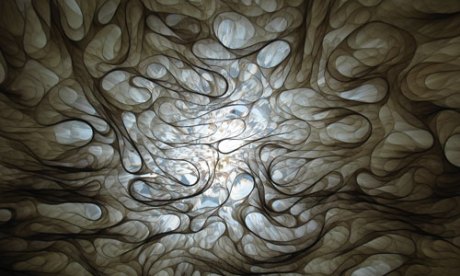Tara Donovan part 3
November 10, 2008
There is something delightful about experiencing a work of art that challenges you in both physical and psychic ways—ultimately evoking a sense of joy through wonderment. Over the past few years I have shifted my taste in art from one that seeks mental and emotional affectation to one that seeks delight through curiosity. I suppose that this shift signals a broader movement from critical apprehension to optical effect/affect. What ever the case, I am encouraged to see that the exposition of raw technique has enabled a broader spectrum of viewers to be engaged by the art, and that the technical methodology of Donovan’s work is capable of developing an immediate dialogue between different disciplines.
The interdisciplinary qualities of Donavan’s work emerge from both the naturalistic figuration and the technical assemblage of the work. The technical assemblage of her work is profound in several ways; it is an inspired experiment in self similarity and flexible modularity, it is an experiment in generative geometry, it is an investigation into phenomenal material effects, and it is a conceptual thesis on the nature of synthetic human objects and environments.
The art of critical apprehension is a mode of artistic production that requires a degree of critical literacy in order to appreciate the work. When ever you hear some one say “my five year old could do that.” This is what I am talking about. The art of critical apprehension does a few positive things; it is remarkably open in its ability to absorb new modes of representation and in doing so creates a progressive project that is rich in dialogue. There is a flaw in this however, and it is this, that as this mode of artistic progression has renewed its self over the past 60 years, it has invariably created a canon that is increasingly internal to its own dialogue. In doing so, Art has isolated its self from a broader cultural discourse; it has become an industry of cocktail parties that merits work for its political value rather than its beauty. Beauty is after all the core mission of art.
The art of optical effect/affect comes from a very different place than the art of critical apprehension. When ever you hear some one say “How’d they do that?” this is what I am talking about. The creation of wonderment is an established tradition in art—its roots are intertwined with the Baroque study of the Sublime—and it draws from our inability to immediately comprehend either the scale and or structure of an object. The “affective” qualities of Donavan’s work is perhaps best illustrated in her “Bluffs” sculpture which is constructed from stacked and corbelled clear buttons. This sculpture is optically affective because it appears to blur in a very discomforting way, and although this is also a material effect, it is one of the only sculptures that I have seen which has physically affected me. Donovan’s work is at its most Sublime when it has deployed the simplest of materials without the use of adhesives, as illustrated by her “Toothpick Cube”, which exploits the stacking and tangling qualities of the toothpick mass to form the material into a perfect cube. All of Donavan’s work transforms the basic materials into new textures and forms, that through self similarity and aggregation create remarkable new material phenomena, it is an art of special effects, made even more profound by its total rejection of cosmetics.






